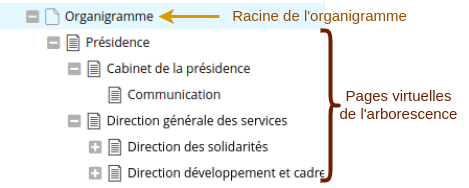Cette fonctionnalité est disponible à partir de la version 2.12
Organigramme Description Surcharges Annuaire Description Surcharges Exemple Organigramme Description Dans l’organigramme, il y a un type de page virtuelle.
Surcharges
Description
Nom du fichier de surcharge
Fichier de configuration par défaut
Pages de l’arborescence de l’organigramme de n’importe quel niveau
userdirectory.orgunit.xml
<model template="udorgunit">
<zone id="default">
<content view="main"/>
</zone>
</model> <model template="udorgunit">
<zone id="default">
<content view="main"/>
</zone>
</model>
<model template="udorgunit">
<zone id="default">
<content view="main"/>
</zone>
</model>
Rappel : Le fichier de surcharge devra donc se nommer : userdirectory.orgunit.xml
Annuaire Description Dans l’annuaire, il y a deux types de pages virtuelles.
Surcharges
Description
Nom du fichier de surcharge
Fichier de configuration par défaut
Fichier de configuration par défaut
Pages intermédiaires de l'arborescence de l'annuaire
userdirectory.user-transitional.xml
<model template="page">
<zone id="default">
<service id="org.ametys.web.service.SitemapService">
<parameters>
<depth i18n="false">1</depth>
<all i18n="false">false</all>
<includeInvisiblePage i18n="false">true</includeInvisiblePage>
</parameters>
</service>
</zone>
</model> <model template="page">
<zone id="default">
<service id="org.ametys.web.service.SitemapService">
<parameters>
<depth i18n="false">1</depth>
<all i18n="false">false</all>
<includeInvisiblePage i18n="false">true</includeInvisiblePage>
</parameters>
</service>
</zone>
</model>
<model template="page">
<zone id="default">
<service id="org.ametys.web.service.SitemapService">
<parameters>
<depth i18n="false">1</depth>
<all i18n="false">false</all>
<includeInvisiblePage i18n="false">true</includeInvisiblePage>
</parameters>
</service>
</zone>
</model>
<model template="page">
<zone id="default">
<service id="org.ametys.web.service.SitemapService">
<depth i18n="false">1</depth>
<all i18n="false">false</all>
<includeInvisiblePage i18n="false">true</includeInvisiblePage>
</service>
</zone>
</model> <model template="page">
<zone id="default">
<service id="org.ametys.web.service.SitemapService">
<depth i18n="false">1</depth>
<all i18n="false">false</all>
<includeInvisiblePage i18n="false">true</includeInvisiblePage>
</service>
</zone>
</model>
<model template="page">
<zone id="default">
<service id="org.ametys.web.service.SitemapService">
<depth i18n="false">1</depth>
<all i18n="false">false</all>
<includeInvisiblePage i18n="false">true</includeInvisiblePage>
</service>
</zone>
</model>
Dernières pages de l'arborescence de l'annuaire
userdirectory.user.xml
<model template="user-page">
<zone id="default">
<content view="main"/>
</zone>
</model> <model template="user-page">
<zone id="default">
<content view="main"/>
</zone>
</model>
<model template="user-page">
<zone id="default">
<content view="main"/>
</zone>
</model> Si ce fichier redéfinit la vue du contenu, celle-ci sera ignorée : c'est la vue définie lors de la configuration de la racine de l'annuaire qui prévaut.
<model template="user-page">
<zone id="default">
<content view="main"/>
</zone>
</model> <model template="user-page">
<zone id="default">
<content view="main"/>
</zone>
</model>
<model template="user-page">
<zone id="default">
<content view="main"/>
</zone>
</model> Si ce fichier redéfinit la vue du contenu, celle-ci sera ignorée : c'est la vue définie lors de la configuration de la racine de l'annuaire qui prévaut.
Rappel : Les fichiers de surcharge devront donc se nommer : userdirectory.user-transitional.xml pour les pages intermédiaires de l'arborescence et userdirectory.user.xml pour les pages contenant les utilisateurs
Exemple Surcharge des pages virtuelles de l’arborescence de l’organigramme (userdirectory.orgunit.xml) pour ajouter un service Plan du site au dessous du contenu Entités
<model template="page">
<zone id="default">
<service id="org.ametys.web.service.SitemapService">
<parameters>
<depth i18n="false">1</depth>
<all i18n="false">false</all>
<includeInvisiblePage i18n="false">true</includeInvisiblePage>
</parameters>
</service>
<content view="main"/>
</zone>
</model> <model template="page">
<zone id="default">
<service id="org.ametys.web.service.SitemapService">
<parameters>
<depth i18n="false">1</depth>
<all i18n="false">false</all>
<includeInvisiblePage i18n="false">true</includeInvisiblePage>
</parameters>
</service>
<content view="main"/>
</zone>
</model>
<model template="page">
<zone id="default">
<service id="org.ametys.web.service.SitemapService">
<parameters>
<depth i18n="false">1</depth>
<all i18n="false">false</all>
<includeInvisiblePage i18n="false">true</includeInvisiblePage>
</parameters>
</service>
<content view="main"/>
</zone>
</model>

